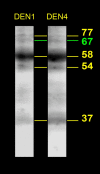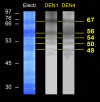Dengue viruses binding proteins from Aedes aegypti and Aedes polynesiensis salivary glands
- PMID: 19320997
- PMCID: PMC2670272
- DOI: 10.1186/1743-422X-6-35
Dengue viruses binding proteins from Aedes aegypti and Aedes polynesiensis salivary glands
Abstract
Dengue virus (DENV), the etiological agent of dengue fever, is transmitted to the human host during blood uptake by an infective mosquito. Infection of vector salivary glands and further injection of infectious saliva into the human host are key events of the DENV transmission cycle. However, the molecular mechanisms of DENV entry into the mosquito salivary glands have not been clearly identified. Otherwise, although it was demonstrated for other vector-transmitted pathogens that insect salivary components may interact with host immune agents and impact the establishment of infection, the role of mosquito saliva on DENV infection in human has been only poorly documented. To identify salivary gland molecules which might interact with DENV at these key steps of transmission cycle, we investigated the presence of proteins able to bind DENV in salivary gland extracts (SGE) from two mosquito species. Using virus overlay protein binding assay, we detected several proteins able to bind DENV in SGE from Aedes aegypti (L.) and Aedes polynesiensis (Marks). The present findings pave the way for the identification of proteins mediating DENV attachment or entry into mosquito salivary glands, and of saliva-secreted proteins those might be bound to the virus at the earliest step of human infection. The present findings might contribute to the identification of new targets for anti-dengue strategies.
Figures



Similar articles
-
Effect of dengue-2 virus infection on protein expression in the salivary glands of Aedes aegypti mosquitoes.Am J Trop Med Hyg. 2014 Mar;90(3):431-7. doi: 10.4269/ajtmh.13-0412. Epub 2014 Jan 20. Am J Trop Med Hyg. 2014. PMID: 24445208 Free PMC article.
-
Dengue virus replicates and accumulates in Aedes aegypti salivary glands.Virology. 2017 Jul;507:75-81. doi: 10.1016/j.virol.2017.04.009. Epub 2017 Apr 18. Virology. 2017. PMID: 28431281
-
Induction of a peptide with activity against a broad spectrum of pathogens in the Aedes aegypti salivary gland, following Infection with Dengue Virus.PLoS Pathog. 2011 Jan 13;7(1):e1001252. doi: 10.1371/journal.ppat.1001252. PLoS Pathog. 2011. PMID: 21249175 Free PMC article.
-
Barriers to preclinical investigations of anti-dengue immunity and dengue pathogenesis.Nat Rev Microbiol. 2013 Jun;11(6):420-6. doi: 10.1038/nrmicro3030. Epub 2013 May 8. Nat Rev Microbiol. 2013. PMID: 23652323 Review.
-
Research progress toward the influence of mosquito salivary proteins on the transmission of mosquito-borne viruses.Insect Sci. 2024 Jun;31(3):663-673. doi: 10.1111/1744-7917.13193. Epub 2023 Apr 5. Insect Sci. 2024. PMID: 37017683 Review.
Cited by
-
Sialic acid expression in the mosquito Aedes aegypti and its possible role in dengue virus-vector interactions.Biomed Res Int. 2015;2015:504187. doi: 10.1155/2015/504187. Epub 2015 Mar 22. Biomed Res Int. 2015. PMID: 25874215 Free PMC article.
-
Dengue virus infection perturbs lipid homeostasis in infected mosquito cells.PLoS Pathog. 2012;8(3):e1002584. doi: 10.1371/journal.ppat.1002584. Epub 2012 Mar 22. PLoS Pathog. 2012. PMID: 22457619 Free PMC article.
-
Nature, nurture and evolution of intra-species variation in mosquito arbovirus transmission competence.Int J Environ Res Public Health. 2013 Jan 11;10(1):249-77. doi: 10.3390/ijerph10010249. Int J Environ Res Public Health. 2013. PMID: 23343982 Free PMC article. Review.
-
Traditional Knowledge to Contemporary Medication in the Treatment of Infectious Disease Dengue: A Review.Front Pharmacol. 2022 Mar 14;13:750494. doi: 10.3389/fphar.2022.750494. eCollection 2022. Front Pharmacol. 2022. PMID: 35359838 Free PMC article. Review.
-
[Three-dimensional morphology of C6/36 cells infected by dengue virus: a study based on digital holographic microscopy].Nan Fang Yi Ke Da Xue Xue Bao. 2017 Mar 20;37(3):301-307. doi: 10.3969/j.issn.1673-4254.2017.03.04. Nan Fang Yi Ke Da Xue Xue Bao. 2017. PMID: 28377343 Free PMC article. Chinese.
References
-
- World Health Organization Impact of Dengue http://www.who.int/csr/disease/dengue/impact/en/index.html
-
- Bancroft TL. On the aetiology of dengue fever. Australian Medical Gazette. 1906;25:17–18.
-
- Rosen L, Rozeboom LE, Sweet BH, Sabin AB. The transmission of dengue by Aedes polynesiensis Marks. Am J Trop Med Hyg. 1954;3:878–882. - PubMed
-
- Kuberski T. Fluorescent antibody studies on the development of dengue-2 virus in Aedes albopictus (Diptera: Culicidae) J Med Entomol. 1979;16:343–349. - PubMed
MeSH terms
Substances
LinkOut - more resources
Full Text Sources

